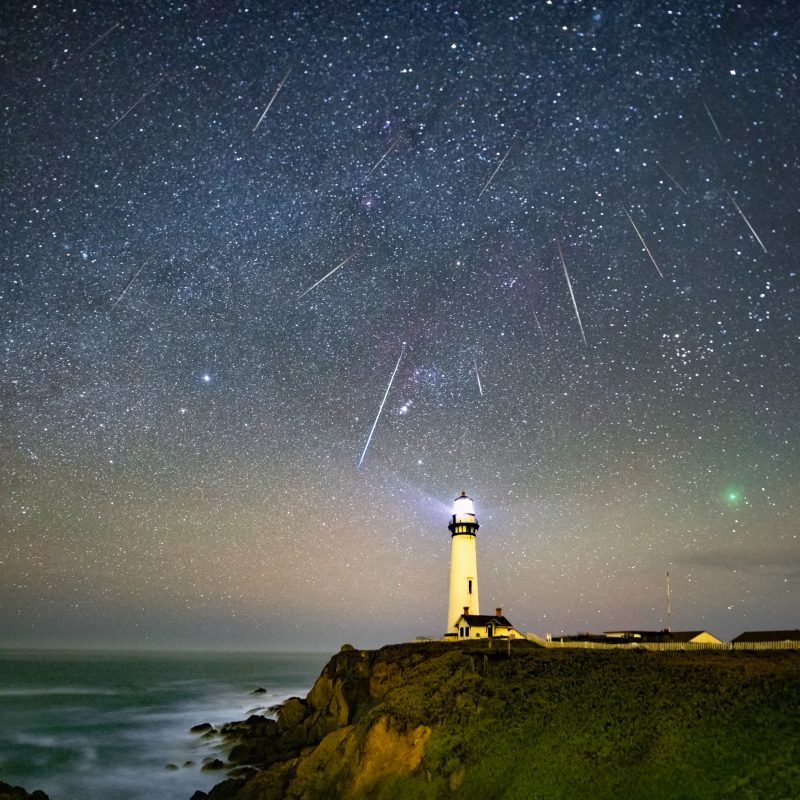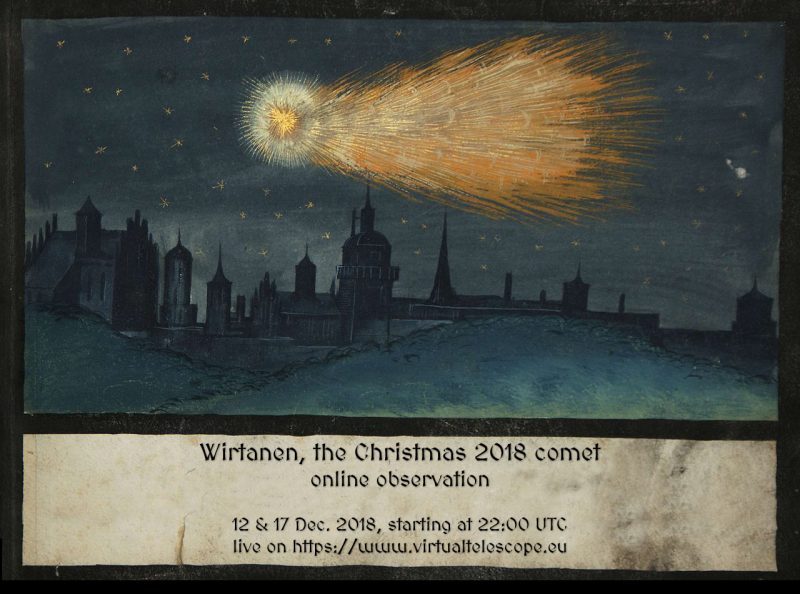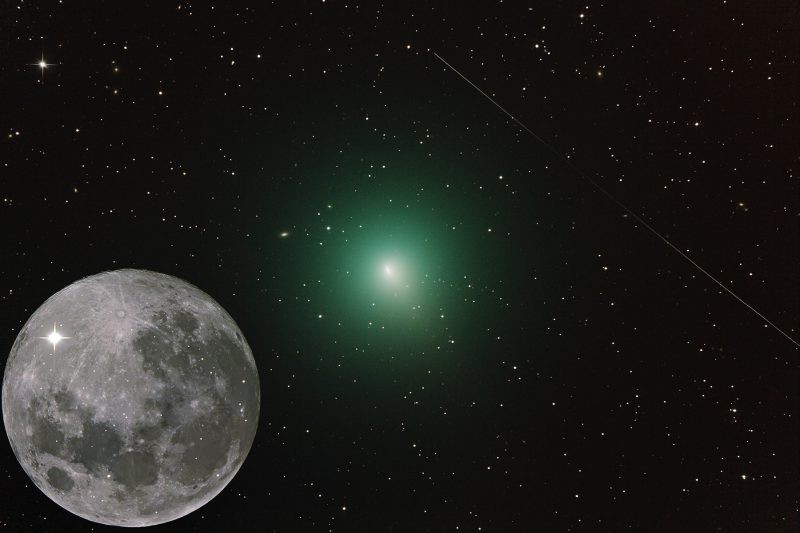
Have you heard about comet 46P/Wirtanen? It has been zooming through the inner solar system, approaching Earth’s vicinity at a speed of about 6 miles per second (10 km/s). As it’s come nearer, the comet has brightened and should be brightest around December 16, when it passes closest to Earth, within 7.4 million miles (12 million km). Comet Wirtanen is the brightest comet in the night sky now; it’s the brightest comet of 2018. The comet sweeps closest to Earth just a few days after being closest to the sun on December 12. Closest approach to Earth happens on December 16 at 13:05 UTC (8:05 a.m. EST; translate UTC to your time).
Although bright enough, strictly speaking, to be visible to the eye now, this comet is not easily visible to the eye. Astronomers have captured it using telescopes and binoculars (see a collection of photos here). We heard from one experienced observer this weekend who said she glimpsed it – briefly, and through an 8-inch telescope – from the parking lot of a car dealership, in the middle of a city.
Yet comet 46P/Wirtanen is still best seen from a dark location. To get a look at it, use the chart in this post. Or check to see if your local astronomy club is hosting an event for observing comet 46P/Wirtanen. Or visit the Virtual Telescope Project for a free, online viewing of comet Wirtanen on December 17.
Want to try to spot the comet yourself, in a dark sky? Keep reading …
See it! Images of comet 46P/Wirtanen here
The 2019 lunar calendars are here! Order yours before they’re gone. Makes a great gift.

As of early December, observers around the world are reporting that Comet 46P/Wirtanen is, in theory, bright enough to be seen with the eye. The problem is that the dim light reflected from the comet is spread over a large cometary atmosphere, or coma.
So you’ll be looking for a large, diffuse, dim object.
The comet is moving in front of the stars from one night to the next. It appears in front of the same stars as seen from both the Northern Hemisphere and the Southern Hemisphere. But, as always, your orientation to these stars is different from different parts of Earth. Where should you look on any given date? See the charts below.
Or, try setting your specific location to this comet Wirtanen page at In-the-Sky.org.
You can also set your location at this site: TheSkyLive’s comet Wirtanen page.
Here’s another helpful article on how to see the comet, from SkyandTelescope.com.


Estimates of the comet’s brightness have varied, but it should now have a visual magnitude of around 3. If the comet were a point source, like a star, it would be of medium brightness! But its diffuse coma and the nearly full moon on December 16 will make observations challenging. On Sunday night, December 16, the moon is 65 percent illuminated.

If you do glimpse comet 46P/Wirtanen in December, here are a few details that might help you appreciate it.
Consider that the comet’s icy nucleus, or core, is less than a mile (just 1.2 km) wide. Meanwhile, its cometary atmosphere – or coma – is bigger, in an absolute sense, than the planet Jupiter.
When you see 46P/Wirtanen, consider the question of comet tails. Due to the orientation in space of Earth and Wirtanen when the comet is closest, the ion tail will be behind the comet, not visible from Earth’s perspective. So far, we haven’t seen much of a tail at all from this comet, but that could change. It might develop a slight curved tail in the coming days; if so, it’ll likely be easier to see in astrophotography than with the unaided eye.
Finally, if you are glimpsing the comet with optical aid, you might be able to discern this comet’s movement in front of the stars. Careful observations of the comet – in particular with a small telescope – should let you perceive its motion relative to the stars, over about a 30-minute period. The video below, from Tom Wildoner, shows you the comet’s movement.
Whether or not you see comet 46P/Wirtanen, it’ll be fun to contemplate this comet’s 2018 passage near the Earth and sun. According to astronomers at the University of Maryland, this passage of comet Wirtanen near the Earth (near by comet standards, that is) will be the 10th closest approach of a comet in modern times.
At its closest to us, the comet will be about 30 times the moon’s distance (7.1 million miles, or 11.5 million km).
The record for the closest observed comet – for all of recorded history – goes to D/1770 L1 Lexell, which came to less than six times the Earth-moon distance in June 1770.
Or, contrast Wirtanen’s closest appraoch – 30 times the moon’s distance, 7.1 million miles, or 11.5 million km – to another comet that swept relatively near us recently, 21P/Giacobini-Zinner, causing a brief outburst in this year’s Draconid meteor shower. Giacobini-Zinner swept closest to Earth on September 9-10, 2018, at 36 million miles (58 million km). That was the closest Giacobini-Zinner had come in 72 years!
So you see comets are elusive objects. They don’t come very close, usually, in any absolute sense. Still, this 2018 approach is a good one for comet Wirtanen.

And there is more …
Between December 6 and 12, 2018, comet 46P/Wirtanen enters an area of the sky where, as seen from our perspective, there is an orbiting ring of some 450 active geostationary satellites.
This belt of meteorological, television and other communication satellites orbits our planet at about 22,236 miles (35,786 km) above Earth’s equator. Because these satellites orbit our planet at the same speed that Earth rotates, geostationary satellites appear to be motionless, at a fixed position in the sky, thus explaining why the small satellite dishes on the roofs of our houses are pointing at a fixed position.
Because they orbit so high above Earth, these satellites are illuminated by the sun most of the time.
Observers using telescopes with a small motor that tracks astronomical objects in the sky, compensating for the Earth’s rotation, will perceive the slow motion of these satellites passing in front of the comet and stars. The view will be similar to the one seen on this video:
If the object appears to cross the field of view in the telescope fairly fast, you are likely looking at a satellite in low-Earth orbit. But if the satellite is moving slowly and remains visible several seconds through the telescope, you are probably seeing one of many geostationary satellites that will be visible in the path of comet Wirtanen from early to mid-December.
Sometimes, geostationary satellites may be visible in groups of three or more.
Can you confirm you are looking at a geostationary satellite at the eyepiece? Yes. If you are a using a computerized or tracking telescope, center the slow-moving object in the field of view. Then turn off the telescope or tracking function. If it’s a geostationary satellite, it will remain centered and now all the stars will appear to slowly drift as Earth rotates.
Keep in mind that you might have to re-align the telescope to continue observing the comet or other astronomical objects. Have fun!
Bottom line: Comet 46P/Wirtanen is due to pass closest to the sun on December 12, 2018, and closest to Earth just a few days later, on December 16. It’s theoretically visible to the eye now, but is large and diffuse … not easy to see. Charts, tips and other info here.











